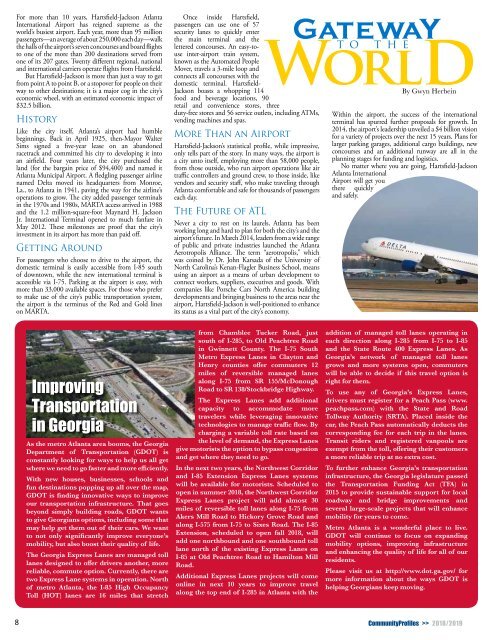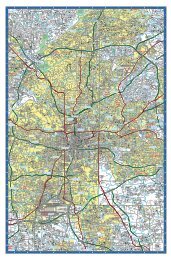2018 Atlanta CommunityProfiles
Create successful ePaper yourself
Turn your PDF publications into a flip-book with our unique Google optimized e-Paper software.
For more than 10 years, Hartsfield-Jackson <strong>Atlanta</strong><br />
International Airport has reigned supreme as the<br />
world’s busiest airport. Each year, more than 95 million<br />
passengers—an average of about 250,000 each day—walk<br />
the halls of the airport’s seven concourses and board flights<br />
to one of the more than 200 destinations served from<br />
one of its 207 gates. Twenty different regional, national<br />
and international carriers operate flights from Hartsfield.<br />
But Hartsfield-Jackson is more than just a way to get<br />
from point A to point B, or a stopover for people on their<br />
way to other destinations; it is a major cog in the city’s<br />
economic wheel, with an estimated economic impact of<br />
$32.5 billion.<br />
History<br />
Like the city itself, <strong>Atlanta</strong>’s airport had humble<br />
beginnings. Back in April 1925, then-Mayor Walter<br />
Sims signed a five-year lease on an abandoned<br />
racetrack and committed his city to developing it into<br />
an airfield. Four years later, the city purchased the<br />
land (for the bargain price of $94,400) and named it<br />
<strong>Atlanta</strong> Municipal Airport. A fledgling passenger airline<br />
named Delta moved its headquarters from Monroe,<br />
La., to <strong>Atlanta</strong> in 1941, paving the way for the airline’s<br />
operations to grow. The city added passenger terminals<br />
in the 1970s and 1980s, MARTA access arrived in 1988<br />
and the 1.2 million-square-foot Maynard H. Jackson<br />
Jr. International Terminal opened to much fanfare in<br />
May 2012. These milestones are proof that the city’s<br />
investment in its airport has more than paid off.<br />
Getting Around<br />
For passengers who choose to drive to the airport, the<br />
domestic terminal is easily accessible from I-85 south<br />
of downtown, while the new international terminal is<br />
accessible via I-75. Parking at the airport is easy, with<br />
more than 33,000 available spaces. For those who prefer<br />
to make use of the city’s public transportation system,<br />
the airport is the terminus of the Red and Gold lines<br />
on MARTA.<br />
Once inside Hartsfield,<br />
passengers can use one of 57<br />
security lanes to quickly enter<br />
the main terminal and the<br />
lettered concourses. An easy-touse<br />
inter-airport train system,<br />
known as the Automated People<br />
Mover, travels a 3-mile loop and<br />
connects all concourses with the<br />
domestic terminal. Hartsfield-<br />
Jackson boasts a whopping 114<br />
food and beverage locations, 90<br />
retail and convenience stores, three<br />
duty-free stores and 56 service outlets, including ATMs,<br />
vending machines and spas.<br />
More Than an Airport<br />
Hartsfield-Jackson’s statistical profile, while impressive,<br />
only tells part of the story. In many ways, the airport is<br />
a city unto itself, employing more than 58,000 people,<br />
from those outside, who run airport operations like air<br />
traffic controllers and ground crew, to those inside, like<br />
vendors and security staff, who make traveling through<br />
<strong>Atlanta</strong> comfortable and safe for thousands of passengers<br />
each day.<br />
The Future of ATL<br />
Never a city to rest on its laurels, <strong>Atlanta</strong> has been<br />
working long and hard to plan for both the city’s and the<br />
airport’s future. In March 2014, leaders from a wide range<br />
of public and private industries launched the <strong>Atlanta</strong><br />
Aerotropolis Alliance. The term “aerotropolis,” which<br />
was coined by Dr. John Karsada of the University of<br />
North Carolina’s Kenan-Flagler Business School, means<br />
using an airport as a means of urban development to<br />
connect workers, suppliers, executives and goods. With<br />
companies like Porsche Cars North America building<br />
developments and bringing business to the areas near the<br />
airport, Hartsfield-Jackson is well-positioned to enhance<br />
its status as a vital part of the city’s economy.<br />
GatewaY<br />
WorlD<br />
to the<br />
By Gwyn Herbein<br />
Within the airport, the success of the international<br />
terminal has spurred further proposals for growth. In<br />
2014, the airport’s leadership unveiled a $4 billion vision<br />
for a variety of projects over the next 15 years. Plans for<br />
larger parking garages, additional cargo buildings, new<br />
concourses and an additional runway are all in the<br />
planning stages for funding and logistics.<br />
No matter where you are going, Hartsfield-Jackson<br />
<strong>Atlanta</strong> International<br />
Airport will get you<br />
there quickly<br />
and safely.<br />
Improving<br />
Transportation<br />
in Georgia<br />
As the metro <strong>Atlanta</strong> area booms, the Georgia<br />
Department of Transportation (GDOT) is<br />
constantly looking for ways to help us all get<br />
where we need to go faster and more efficiently.<br />
With new houses, businesses, schools and<br />
fun destinations popping up all over the map,<br />
GDOT is finding innovative ways to improve<br />
our transportation infrastructure. That goes<br />
beyond simply building roads, GDOT wants<br />
to give Georgians options, including some that<br />
may help get them out of their cars. We want<br />
to not only significantly improve everyone’s<br />
mobility, but also boost their quality of life.<br />
The Georgia Express Lanes are managed toll<br />
lanes designed to offer drivers another, more<br />
reliable, commute option. Currently, there are<br />
two Express Lane systems in operation. North<br />
of metro <strong>Atlanta</strong>, the I-85 High Occupancy<br />
Toll (HOT) lanes are 16 miles that stretch<br />
from Chamblee Tucker Road, just<br />
south of I-285, to Old Peachtree Road<br />
in Gwinnett County. The I-75 South<br />
Metro Express Lanes in Clayton and<br />
Henry counties offer commuters 12<br />
miles of reversible managed lanes<br />
along I-75 from SR 155/McDonough<br />
Road to SR 138/Stockbridge Highway.<br />
The Express Lanes add additional<br />
capacity to accommodate more<br />
travelers while leveraging innovative<br />
technologies to manage traffic flow. By<br />
charging a variable toll rate based on<br />
the level of demand, the Express Lanes<br />
give motorists the option to bypass congestion<br />
and get where they need to go.<br />
In the next two years, the Northwest Corridor<br />
and I-85 Extension Express Lanes systems<br />
will be available for motorists. Scheduled to<br />
open in summer <strong>2018</strong>, the Northwest Corridor<br />
Express Lanes project will add almost 30<br />
miles of reversible toll lanes along I-75 from<br />
Akers Mill Road to Hickory Grove Road and<br />
along I-575 from I-75 to Sixes Road. The I-85<br />
Extension, scheduled to open fall <strong>2018</strong>, will<br />
add one northbound and one southbound toll<br />
lane north of the existing Express Lanes on<br />
I-85 at Old Peachtree Road to Hamilton Mill<br />
Road.<br />
Additional Express Lanes projects will come<br />
online in next 10 years to improve travel<br />
along the top end of I-285 in <strong>Atlanta</strong> with the<br />
addition of managed toll lanes operating in<br />
each direction along I-285 from I-75 to I-85<br />
and the State Route 400 Express Lanes. As<br />
Georgia’s network of managed toll lanes<br />
grows and more systems open, commuters<br />
will be able to decide if this travel option is<br />
right for them.<br />
To use any of Georgia’s Express Lanes,<br />
drivers must register for a Peach Pass (www.<br />
peachpass.com) with the State and Road<br />
Tollway Authority (SRTA). Placed inside the<br />
car, the Peach Pass automatically deducts the<br />
corresponding fee for each trip in the lanes.<br />
Transit riders and registered vanpools are<br />
exempt from the toll, offering their customers<br />
a more reliable trip at no extra cost.<br />
To further enhance Georgia’s transportation<br />
infrastructure, the Georgia legislature passed<br />
the Transportation Funding Act (TFA) in<br />
2015 to provide sustainable support for local<br />
roadway and bridge improvements and<br />
several large-scale projects that will enhance<br />
mobility for years to come.<br />
Metro <strong>Atlanta</strong> is a wonderful place to live.<br />
GDOT will continue to focus on expanding<br />
mobility options, improving infrastructure<br />
and enhancing the quality of life for all of our<br />
residents.<br />
Please visit us at http://www.dot.ga.gov/ for<br />
more information about the ways GDOT is<br />
helping Georgians keep moving.<br />
8<br />
<strong>CommunityProfiles</strong> >> <strong>2018</strong>/2019














![[DC-2017] NorthFulton CommunityProfiles-020317](https://img.yumpu.com/56831475/1/190x247/dc-2017-northfulton-communityprofiles-020317.jpg?quality=85)

